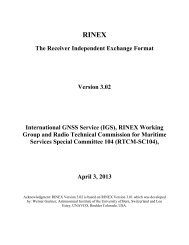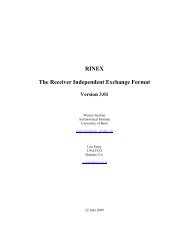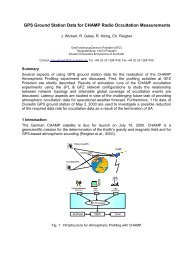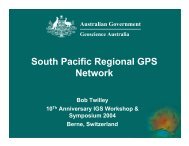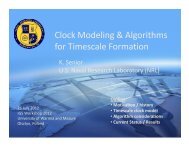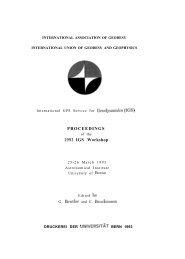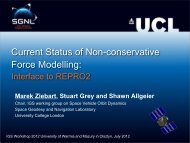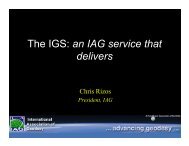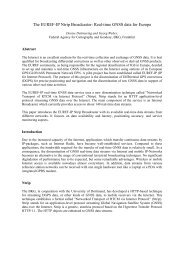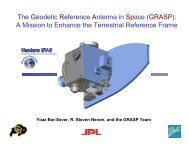IGS Analysis Center Workshop - IGS - NASA
IGS Analysis Center Workshop - IGS - NASA
IGS Analysis Center Workshop - IGS - NASA
You also want an ePaper? Increase the reach of your titles
YUMPU automatically turns print PDFs into web optimized ePapers that Google loves.
Thus, there is the potential of feedback to the scientific community in return for the servicerole provided to the surveying community. With a sufficiently dense network in southernCalifornia, satellite clock information, tropospheric and possibly ionospheric correctionscould also be made available.As an example of this scenario, we choose the two newest stations in the PGGA, LakeMathews in Riverside County and Pales Verdes in the Los Angeles Basin, about 90 kmapart (Figure 7). We consider Lake Mathews the known site (base station) and PalesVerdes a new site to be surveyed. The surveyor requires the base (RINEX) data for LakeMathews and Pales Verdes, the (time-tagged) coordinates of Lake Mathews and the <strong>IGS</strong>orbits for the period of the survey. Figure 8 demonstrates the precision that can beobtained in this scenario for the coordinates of the Pales Verdes site with a single 24-houroccupation. It shows the time history of 4 months of daily solutions using GAMIT, S10orbits (generated independently of these two sites), and ITRF91 coordinates for LakeMathews. The rms scatter of the baseline components from is 2,6 mm in north, 3,4 mm ineast, and 13.9 mm in the vertical, which is more than an order of magnitude better thanusing the broadcast ephemerides [Zhang, 1993].As another example, Tsuji et al. [1993] use the JPL precise ephemerides (as distributed bythe <strong>IGS</strong>) as fixed parameters, and estimate the daily coordinates of a regional network ofMinimac receivers in Japan for a period spanning June 1992 to August 1993. The globalnetwork site, Usuda, was also used as a single “common station” in the regional analysis.The resulting regional baseline was reported to be 1 to 2 parts in 10s in all threecomponents over distances of 1000 km. The cpu time for the daily data reduction of the 5-station regional array was 10 minutes using the GIPSY/OASIS-11 software on aHP900W735 workstation, which is over an order of magnitude less time than it would havetaken with a full global approach.Scenario 2. A multi-year project measures crustal deformation by running several weeklong, epoch-type campaigns every 1-2 years. To analyze a campaign <strong>IGS</strong> (clean RINEX)data simultaneously visible from the surveyed region are retrieved, including stationcoordinates and velocities, satellite initial conditions for the days of the survey, and thesolution files from the global <strong>IGS</strong> analysis. The survey data are analyzed simultaneouslywith the regional subset of the <strong>IGS</strong> data with orbit improvement to produce a second set ofsolution files, using the same physical models (software) and the epoch of the satelliteinitial conditions. The two sets of solution files can be combined easily to produce a set ofcoordinates for the survey stations with respect to the ITRF. Station velocities arecomputed by combining repeated measurements of the crustal deformation network.As an example, we refer to an ongoing project to measure crustal deformation across thetectonically active Indonesian archipelago [Purztodewo et al., 1993]. In 1991 and 1992a 6-station network was surveyed in Irian Jaya, the western part of the island of New Guinea,spanning the plate boundary between the Australian and Pacific Plates (Figure 9). In 1991,the data were analyzed in a simultaneous adjustment of global tracking and regional datasince the total number of stations was manageable. In 1992, the analysis was divided intotwo steps. In the first step, the Irian Jaya data were analyzed (10 stations in 1992) withdata from all <strong>IGS</strong> stations that had mutual visibility with those sites. Since the complete<strong>IGS</strong> data set analyzed at S10 was available in clean RINEX format, it was an easy exerciseto,clean thg Irian Jaya data with the subset of the <strong>IGS</strong> data (incidentally, this ensured thatthe data could be processed later in any combination without any further editing). Initialconditions for the satellite state vectors were obtained from the <strong>IGS</strong> orbits and asimultaneous adjustment of the Irian Jaya and regional <strong>IGS</strong> data with orbit improvementwas performed. Using three sets of solution files (the 1991 set, the 1992 total <strong>IGS</strong> set, and83




